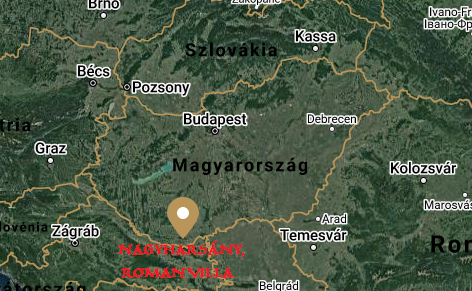Somehow Hungary was not too strong in the research of the Roman villas. Archaeologist was focusing mostly on bigger cities, settlements. Villas shows up mostly because of a new construction, motorway building etc. There is a little conscious research. After a plough a fantastic mosaic appeared from the soil. This. See it first.

The excavations have been going on since 2016, and a wonderful, luxury villa unfolded. This is the area of Villány, the foot of the Szársomlyó hill. If you like wine, Villány can be familiar, because that is one of the most famous Hungaricums. Romans also liked this part of Hungary. The weather is a bit different than the other parts of the country. The hill is a vulcanic-hill, so soil is perfect for a vineyard. The weather is mediterranean in this area, so the settling Romans felt themselves a little at home. This means that this is the place where the sun shines the most in a year. The other favourite place for the Romans was the area of Lake Balaton, still one of the favourite places in Hungary (not just for the visitors, tourists, but we, Hungarians also love the lake - we call it the Hungarian Sea).
The foot of the Szársomlyó Hill was populated in the 1st century AD. A small village was founded here and the luxury villa. Stone buildings appeared in the Severian-age (193-235 AD). The villa - where the mosaic was found - initially was an average Roman villa, it became a luxury villa sometime during the 4th century. New feast room, gardens, separate bath house was built to serve the comfort of the residents.
A little curiosity, that the place was known for the archaeologists, because many Roman foundings appeared from here. But there was no excavation, just in 2016, after the plough. You may ask why? That is a perfect question! There are many places which are known as a Roman villa/building/settlement or simply a site, but there are no excavations. During decades, centuries. Why? They say, because of money. But I don't believe that.
So back to our fascinating villa, unfortunately the mosaic was in the great hall and directly the mosaic was polwed through.
Who was the owner of this villa? Imagine a wealthy Roman man. A really rich and powerful man. Rich as the man known as Seuso who owned a huge 'treasure': we don't know how many gold, gilded and silver vessels. Some of them were found and still visitable in Hungary, but not known how many is lost, hiding, or maybe lost forever. So the owner of this richness must have been a prominent man, a well-educated person with a family. They could not enjoy the wealth for long: sometime in the middle of the 5th century AD they had left the villa and Pannonia Provicia because of the Barbarian (Hun) invasions and attacks. The Huns occupied the land of Pannonia, Romans left and maybe went back to Italian lands.
Now see the possibilities. An insripiton was found in the area, now you can see it in the Hungarian National Museum. This mentions a senator, Valerius Dalmatius, a lawyer, who was the former governor of GALLIA LUGDUNENSIS TERTIA (now the area of Normandy). He was respected and beloved, he was a fair man, so people erected him a statue which was placed in his motherland, in Pannonia. Researchers found that the city protector Godessess shows us, that this prominent Valerius Dalmatius was the owner of this luxury villa. I really believe this theory.
 |
Szársomlyó Hill
|
The mosaic was found in a huge feast room, but that was not the only mosaic ornamented room. This scene showed a large hunting scene, and in the middle of the mosaic, the main topic was the lady on the first picture: she is a proud Goddess, protector of cities. Like the Goddess Tyche in the Roman Savaria, the modern city now called Szombathely. Ok, it is a contemporary sculpture, but you can see how beautiful and proud she was, like other Godessess, whose job was to protect cities. And see her crown, that is the most important part. It shows a wall of a city! And on the mosaic what we can see is not a diadem, but a wall-crown.
 |
Goddess Tyche, protector of Szombathely (the Roman Savaria)
|
And for the final, let's see the floor plan of the main piece of the villa, where the mosaic was found! 'M' means a place where some kind of mosaics were found.
 |
not this piece was the only one
|
 |
a sight what a bird see from the large hall, where the mosaic was found
|






Comments
Post a Comment